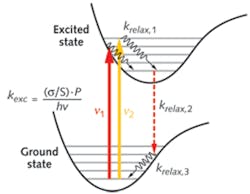OPTICAL DETECTION/CELL BIOLOGY: Three approaches succeed in non-fluorescent single-molecule absorption detection
Optical detection at single-molecule sensitivity, a capability important for molecular biology, was originally accomplished at cryogenic temperatures. At ambient conditions, such detection is much more challenging, but recently three groups reported advances in single molecule absorption detection at room temperature. Each uses a different approach, and each bypasses the use of fluorophores. The standard method for the past two decades, fluorescence requires exacting conditions, and because only a small fraction of chromophores (that is, absorbing molecules) are strongly fluorescent, it misses the opportunity to leverage the many nonfluorescent chromophores important to biology. However, because direct detection at room temperature is not a background-free measurement and is often complicated by sample scattering, each of the newly published approaches uses innovative methods.
For instance, a team at Harvard University has demonstrated the use of stimulated emission to distinguish absorption from scattering: stimulated photons can arise only from the excited state of molecules.1 With a modulated stimulating beam, they were able to image absorption in cells down to a few tens of molecules. Their approach involves ground-state depletion microscopy with a high-frequency dual-beam modulation transfer scheme (CW lasers) and use of an organic dye, Atto647N. While ground-state depletion (nonlinear saturation spectroscopy) has been used in the past for super-resolution microscopy, the group used it in a different way to provide a contrast mechanism as well as high sensitivity in absorption-like measurements. This method efficiently rejects Rayleigh scattering of the sample (see figure).
Meanwhile, in the same issue of The Journal of Physical Chemistry Letters, a team at the Institute of Physics, Leiden University presents its approach based on photothermal contrast.2 "We pushed the sensitivity of photothermal detection to the single-molecule limit, demonstrating a signal-to-noise ratio of about 10 with reasonable integration times of 100 to 300 ms, joined to excellent rejection of the scattering background," the researchers say (see figure). While the work relies on the use of glycerol instead of water (to reduce heat conductivity and increase the refractive index change induced by single-molecule light absorption), and conditions not realistic for single-molecule absorption in a cell, the team asserts that the technique can be optimized further and potentially applied to a much broader variety of absorbing molecules, including metal proteins useful for analytical biochemistry and medical assays. While they note that an intrinsic limitation of the photothermal method is the low transduction factor between pump and probe (because of the relatively weak variation of refractive index with temperature), research for more efficient transduction "appears full of promise."While photothermal contrast generally relies on the intensity change of a probe beam caused by a modulated heating beam of a different color, researchers in the Laboratory of Physical Chemistry, ETH Zurich say they have demonstrated that single molecules can be detected via standard modulation-free absorption measurements.3 They note that the major difficulty in performing single-molecule absorption detection at room temperature stems from the discrepancy between the absorption cross section (~10-15–10-16 cm2) and the minimum size of a light beam dictated by the diffraction limit (~10-9 cm2). "A simple estimate suggests that to detect the expected absorption effect directly, one would have to suppress any intensity fluctuations in the detected light beam below the parts-per-million level," the researchers report. "However, laser intensity fluctuations are invariably orders of magnitude larger than the desired signal on the time scale of translating the molecule. Furthermore, any background scattering caused by sample inhomogeneities or nearby molecules easily modifies the signal, overwhelming the tiny absorption signature." Their work shows that both of these noise sources can be successfully suppressed by combining balanced detection and an index matched sample geometry—that is, careful selection of a sample substrate. "We thus achieve single-molecule absorption sensitivity in a simple and direct manner, which can be readily implemented in various applications," they explain.
1. S. Chong et al., J. Phys. Chem. Lett. 1, 3316–3322 (2010)
2. P. Kukura et al., J. Phys. Chem. Lett. 1, 3323–3327 (2010)
3. A. Gaiduk et al., Science 330, 353–356 (2010)
About the Author

Barbara Gefvert
Editor-in-Chief, BioOptics World (2008-2020)
Barbara G. Gefvert has been a science and technology editor and writer since 1987, and served as editor in chief on multiple publications, including Sensors magazine for nearly a decade.

